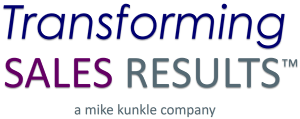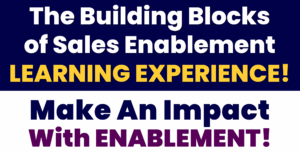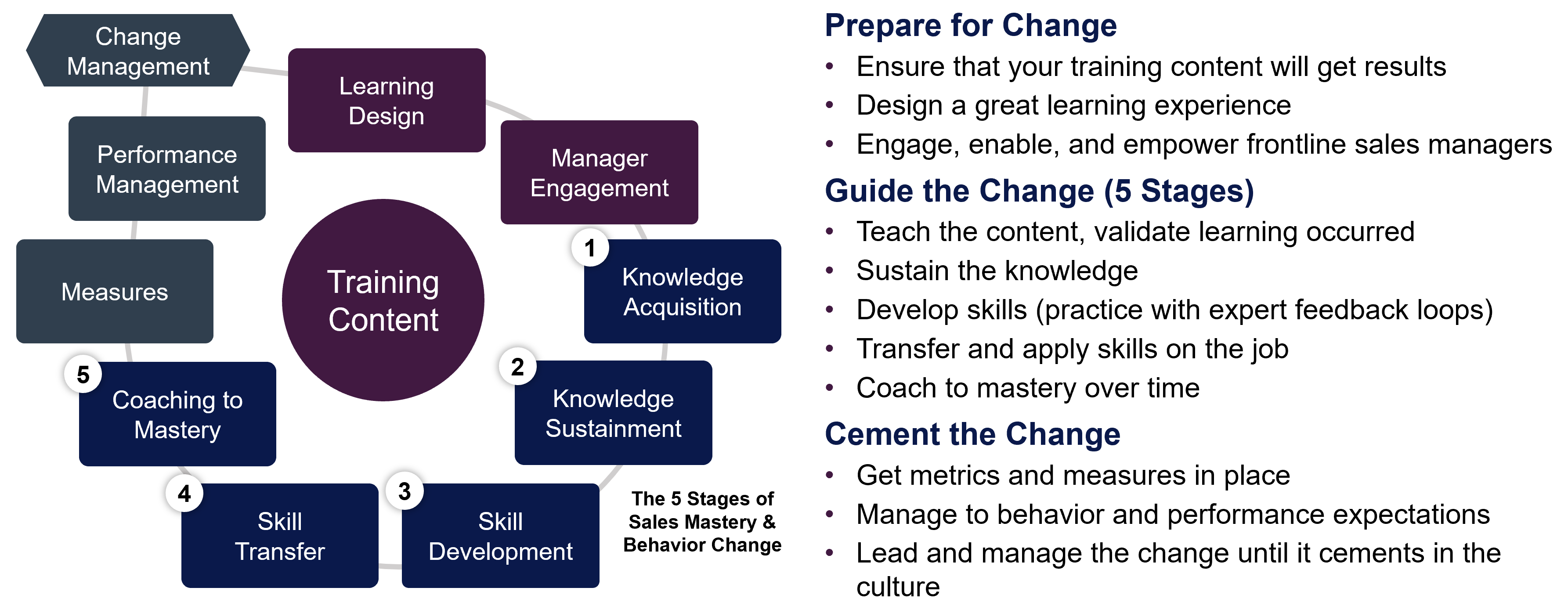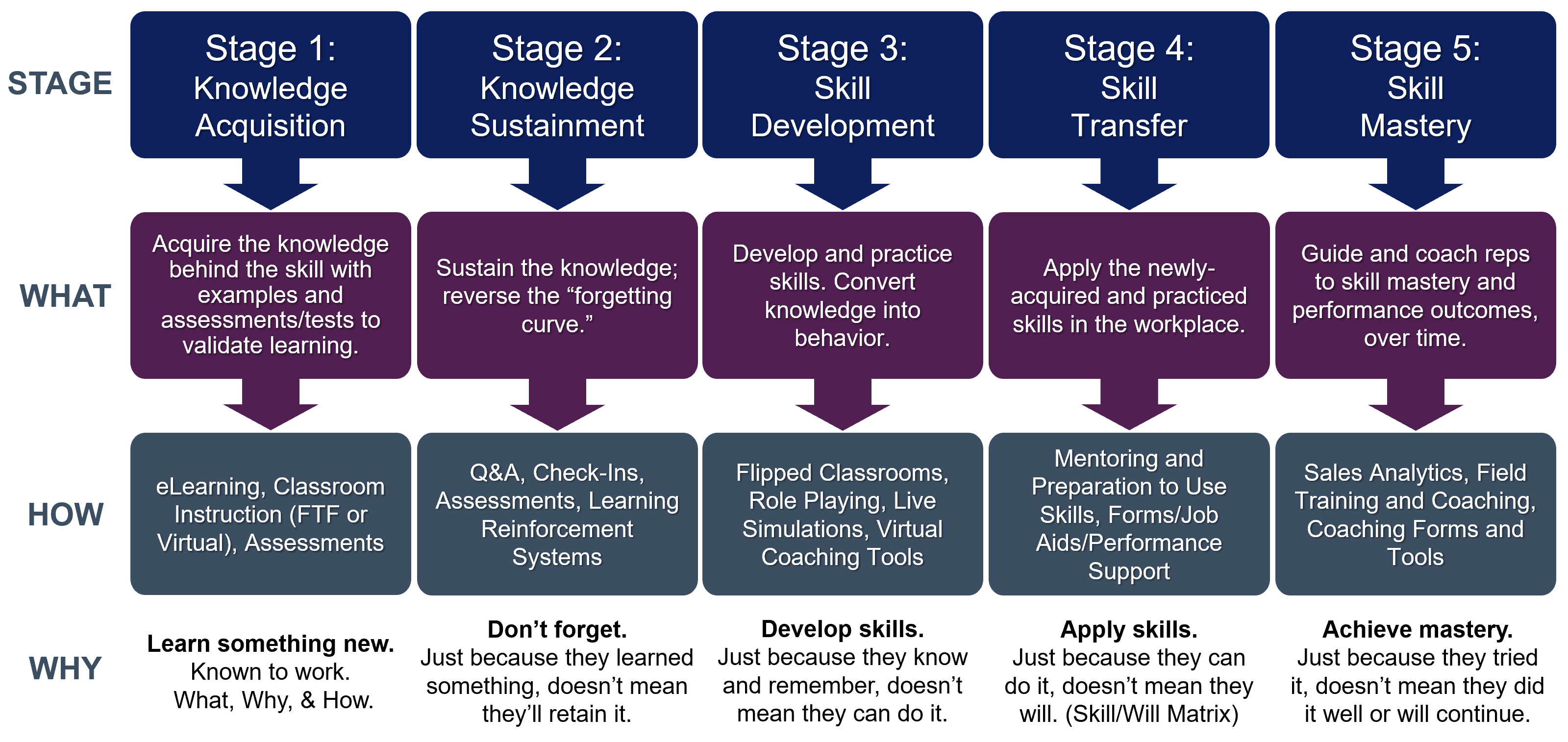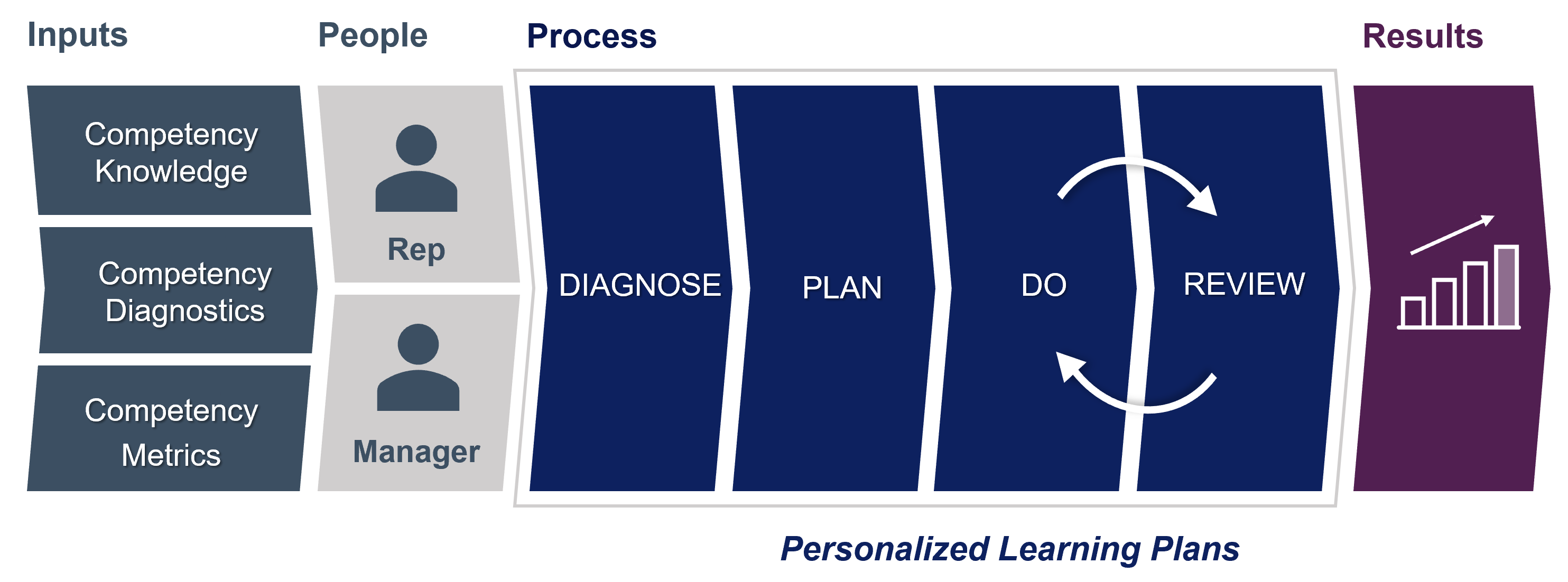What’s Your Strategy for Sales Talent Development? Part 2
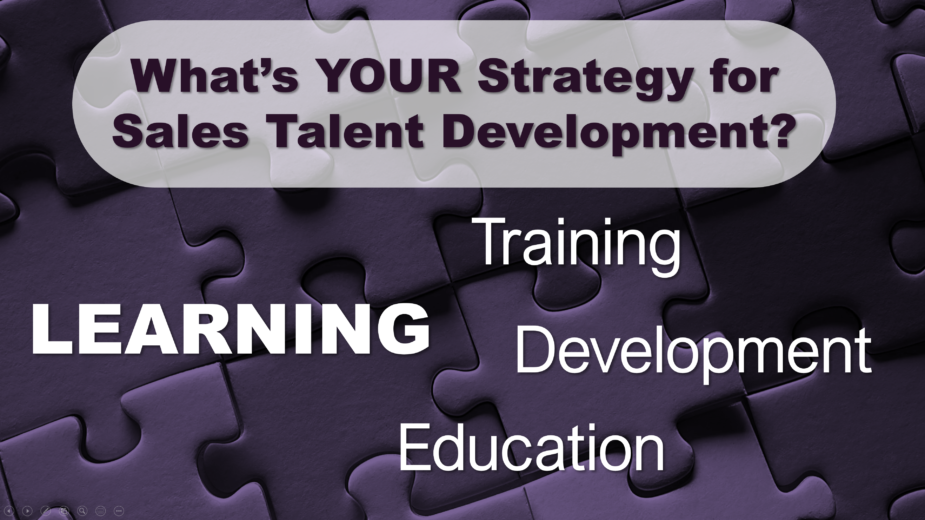
In the first post in this series, I defined Learning, Training, Development, and Education.
- Learning: Learning is the act of acquiring new knowledge and skills.
- Training: Training is job-related learning about what, why, and how (and maybe when and where) to do something (or multiple things), to be successful in a specific role.
- Development: Development is a targeted form of personalized learning to foster career growth.
- Education: Education is generally longer-term learning, for some future purpose. (“Education is not the learning of facts, but the training of the mind to think.”)
In this post, I’ll share strategies for organizational learning that utilize training, development, and education to create a learning culture, close identified competency gaps, and improve sales results.
Goals of Organizational Learning for Sales
Let’s start with a list of the types of organizational learning that you should have in place (or should consider, based on organization size, resources, and budget) to support sales employees.
- Sales onboarding for new sales reps and new or promoted sales managers
- Ongoing competency development for sales and sales management
- Management and leadership development
- Ongoing product updates
- Developing business/financial acumen
- Deepening customer/buying acumen and domain expertise
- Developing a growth mindset
- Developing general “success skills” or business skills (communication, problem-solving, organization/time management, decision making, etc.)
- Supporting the successful implementation of a new
- Supporting a sales performance improvement initiative (from incremental to transformational)
- Supporting strategic business objectives and tactical plans
- Supporting ongoing career development (including rotational or temporary assignments)
- Supporting promotions (preferably “preparing for” but also “post-promotion”)
- Supporting Performance Improvement Plans
- Supporting work-related formal education goals
This list is primarily aimed at frontline sellers (such as sales development reps, business development managers, inside sales, field sales, account executives, and account managers) and their frontline sales managers (sales managers who directly manage those sales reps), but may also include the general management and leadership development for all levels, including senior and top sales leaders.
Depending on your company’s organization design, management and leadership development for sales leaders and executives may be part of your responsibilities or may lie elsewhere, in HR, OD, or Talent Development. In some organizations, I’ve been responsible for management and leadership development. In others I’ve been responsible for only the sales-specific portions of leader/executive development. And in a few, I’ve had no responsibility for leadership development beyond the frontline sales managers. In all cases, I still recommend cross-functional collaboration.
The Strategic Application of Learning Strategy by Type
For sales organizations, I strongly favor training (and the related coaching). I’m sincerely pleased for people to have opportunities to continue to learn and develop or be educated in new things and develop general business skills or further their career. That’s a wonderful talent development practice, aids retention, increases employee satisfaction, and produces a better-educated, well-rounded workforce. I fully support this.
At the same time, those practices rarely move the needle on organizational performance in a big way (transformational sales results). That’s the angle I come from, for sales performance improvement initiatives.
That said, we are discussing organizational learning strategies, so it makes sense to move beyond my normal, purposefully-myopic approach toward improving sales performance, to address the talent management needs across the employee lifecycle. I should note that these practices can have impact – especially improving discretionary effort – so even from a purely business-oriented angle, they do make sense. It’s also the right thing to do. When budget cuts are imminent, however, executives are not always concerned about “the right thing” for employees, so it’s wise to tie these efforts to company performance, whenever possible.
Let’s look at the sales employee lifecycle, through the talent development lens.
Sales Employee Lifecycle
This is an oversimplification for sure and is not “built to scale” from a timeline perspective, but it does follow the path from hire to retire.
A new employee is selected and hired (hopefully very well) and placed into a role in which they can succeed.
They pass through pre-boarding, new-hire orientation, and sales onboarding (role-related training designed to ramp-up the employee to acceptable levels of sales production in the shortest time possible).
To ensure maximum effectiveness, I recommend using a Sales Training System that has been proven effective. The one I built over the years and recommend highly, is:
The 5 Stages of Sales Mastery & Behavior Change
Sales onboarding should provide support for the 5 Stages of Sales Mastery & Behavior Change, which is part of this Sales Training System.
[Recorded webinar on the 5 Stages: http://bit.ly/STSTonSMM-11142017]
- Knowledge Acquisition (in the most efficient, effective, well-designed way possible, validating that learning has occurred)
- Knowledge Sustainment (just because they learned something, doesn’t mean they’ll remember it)
- Skill Development (just because they know what to do and remember, doesn’t mean they can do it)
- Skill Transfer (just because they can do it, doesn’t mean they will)
- Coaching to Mastery (just because they learned, remembered, practiced, and applied a new skill, doesn’t mean they did it well enough or will continue to do it)
After sales onboarding, if hired, trained, coached, and supported well, the new rep should have achieved their learning and performance milestones, be certified (if you do validations or certifications) and be performing at acceptable levels or better.
In the next stage of their lifecycle, they’ll receive:
Ongoing Role Support
This includes software and technology tools, workflow performance support, job aids, policies and procedures, and anything that supports work performance in their current role.
Ongoing Training
This includes ongoing training that is related to their current position, especially the assessment and closing of competency gaps. This includes vehicles for feedback, ongoing coaching, peer collaboration, reading assignments, or other means that are targeted to improve work performance in the current role.
Career Development
This includes ongoing employee development and education, which may be non-skills training or other learning related to their current role, but is more likely employee development (other general work/career skills) or career-pathing toward a new role or promotion.
Performance Management
This includes informal and formal feedback from managers on work performance. It may involve (but is not limited to) periodic performance appraisals or other feedback aimed at documenting, rewarding, or developing the employee’s mindset, behaviors, and competencies that impact their work performance.
70:20:10 Revisited
As mentioned in Part 1, advocates of 70:20:10 suggest that there are three buckets that describe how learning occurs in organizations:
- Formal Learning: a small amount of learning (the 10%) comes through purposefully orchestrated and structured training
- Informal Learning: a slightly larger amount of learning (the 20%) comes from other people, informally through exposure or collaboration/sharing (also referred to as social learning)
- Experiential Learning: the largest amount (the 70%) comes through personal, on-the-job engagement, through day-to-day work experience.
While many of us in the learning profession challenge the exact split of 70:20:10, a friend of mine and well-known HPT and performance improvement expert, Guy Wallace, suggests “most 10, before most 20, before most 70” as a guideline to make this concept workable. I especially believe this is true for sales.
As a part-time curmudgeon and full-time cynic, I believe that even social collaboration, informal learning, and experiential learning are most useful when purposefully orchestrated or at least guided. This is not to say that good things won’t happen on their own, if you foster the right environment. I just don’t like to leave a lot to chance, when sales performance (and my opportunity to fuel it) is on the line.
For example, here are some ways you can promote and support informal learning:
- Use a “Buddy System” (where mentor buddies are prepared and guided)
- Foster sharing between colleagues, top producers, SMEs, executives, sales enablers
- Moderate to safeguard that peer advice is sound (and especially in regulated environments, that it’s legal) and to ensure you don’t have “the blind leading the blind”
- Source and disseminate “best practice” content and “top producer practices” specifically
- Encourage employees to periodically reflect on their own experience and sharing what they’ve learned
- Try structured OJT to drive better experiential learning
Competency Development Framework
Once you have all of this in place, there is still a huge opportunity in almost every sales force to upskill over time to develop true sales mastery. This is where the Competency Development Framework comes in, based on the foundation of sales competencies.
The premise here is simple:
Inputs:
- Teach the competencies and associated sales methodologies
- Use competency diagnostics, either rep self-assessments combined with manager assessments of their reps and/or other competency-based psychometric assessments, to determine competency gaps
- Combine with other sales analytics to pinpoint developmental areas that when competencies improve, will move the needle on the metrics that matter most
People:
- Get reps and their managers engaged and working together. The reps should ultimately own their development, but should receive support, guidance, and coaching from their manager to get to skill mastery
Process:
- After training occurs, I recommend the Diagnose/Plan/Do/Review model, which I write about extensively in my eBook on Sales Coaching Excellence
Results:
- This is an ongoing, looping process, that when done well, will produce excellent performance improvement, in areas where higher mastery will significantly life results.
This is a lot to absorb, I realize, but hopefully having the concepts, frameworks, models and examples in one place, will be helpful as you think through your strategy for sales talent development in the coming year. If you need support on your journey toward sales mastery or with any part of your Sales Training System, you know how to reach me.
__________________________________________________________________
Thanks for reading, be safe out there, and by all means… let’s continue to elevate our sales profession.
Mike
Let’s get connected:
- Transforming Sales Results Blog: https://www.mikekunkle.com/blog
- SMM Connect Webinars: http://bit.ly/STSTonSMM
- BrightTALK Webinars: http://bit.ly/TheSalesExpertsChannel
- LinkedIn Publisher: http://bit.ly/MikeKunkleLIPublisher
- LinkedIn Profile: http://www.linkedin.com/in/mikekunkle
- SlideShare: http://www.slideshare.net/MikeKunkle
- Twitter: https://twitter.com/mike_kunkle
